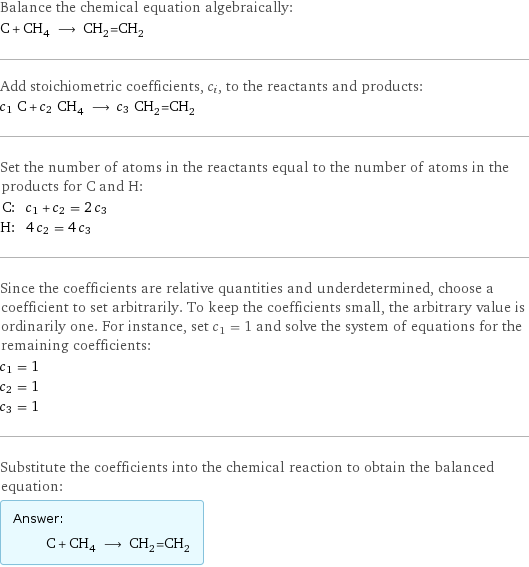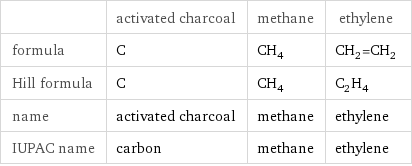Input interpretation

C activated charcoal + CH_4 methane ⟶ CH_2=CH_2 ethylene
Balanced equation

Balance the chemical equation algebraically: C + CH_4 ⟶ CH_2=CH_2 Add stoichiometric coefficients, c_i, to the reactants and products: c_1 C + c_2 CH_4 ⟶ c_3 CH_2=CH_2 Set the number of atoms in the reactants equal to the number of atoms in the products for C and H: C: | c_1 + c_2 = 2 c_3 H: | 4 c_2 = 4 c_3 Since the coefficients are relative quantities and underdetermined, choose a coefficient to set arbitrarily. To keep the coefficients small, the arbitrary value is ordinarily one. For instance, set c_1 = 1 and solve the system of equations for the remaining coefficients: c_1 = 1 c_2 = 1 c_3 = 1 Substitute the coefficients into the chemical reaction to obtain the balanced equation: Answer: | | C + CH_4 ⟶ CH_2=CH_2
Structures

+ ⟶
Names

activated charcoal + methane ⟶ ethylene
Equilibrium constant
![Construct the equilibrium constant, K, expression for: C + CH_4 ⟶ CH_2=CH_2 Plan: • Balance the chemical equation. • Determine the stoichiometric numbers. • Assemble the activity expression for each chemical species. • Use the activity expressions to build the equilibrium constant expression. Write the balanced chemical equation: C + CH_4 ⟶ CH_2=CH_2 Assign stoichiometric numbers, ν_i, using the stoichiometric coefficients, c_i, from the balanced chemical equation in the following manner: ν_i = -c_i for reactants and ν_i = c_i for products: chemical species | c_i | ν_i C | 1 | -1 CH_4 | 1 | -1 CH_2=CH_2 | 1 | 1 Assemble the activity expressions accounting for the state of matter and ν_i: chemical species | c_i | ν_i | activity expression C | 1 | -1 | ([C])^(-1) CH_4 | 1 | -1 | ([CH4])^(-1) CH_2=CH_2 | 1 | 1 | [CH2=CH2] The equilibrium constant symbol in the concentration basis is: K_c Mulitply the activity expressions to arrive at the K_c expression: Answer: | | K_c = ([C])^(-1) ([CH4])^(-1) [CH2=CH2] = ([CH2=CH2])/([C] [CH4])](../image_source/7401d825929d65407d134b51b5585c1a.png)
Construct the equilibrium constant, K, expression for: C + CH_4 ⟶ CH_2=CH_2 Plan: • Balance the chemical equation. • Determine the stoichiometric numbers. • Assemble the activity expression for each chemical species. • Use the activity expressions to build the equilibrium constant expression. Write the balanced chemical equation: C + CH_4 ⟶ CH_2=CH_2 Assign stoichiometric numbers, ν_i, using the stoichiometric coefficients, c_i, from the balanced chemical equation in the following manner: ν_i = -c_i for reactants and ν_i = c_i for products: chemical species | c_i | ν_i C | 1 | -1 CH_4 | 1 | -1 CH_2=CH_2 | 1 | 1 Assemble the activity expressions accounting for the state of matter and ν_i: chemical species | c_i | ν_i | activity expression C | 1 | -1 | ([C])^(-1) CH_4 | 1 | -1 | ([CH4])^(-1) CH_2=CH_2 | 1 | 1 | [CH2=CH2] The equilibrium constant symbol in the concentration basis is: K_c Mulitply the activity expressions to arrive at the K_c expression: Answer: | | K_c = ([C])^(-1) ([CH4])^(-1) [CH2=CH2] = ([CH2=CH2])/([C] [CH4])
Rate of reaction
![Construct the rate of reaction expression for: C + CH_4 ⟶ CH_2=CH_2 Plan: • Balance the chemical equation. • Determine the stoichiometric numbers. • Assemble the rate term for each chemical species. • Write the rate of reaction expression. Write the balanced chemical equation: C + CH_4 ⟶ CH_2=CH_2 Assign stoichiometric numbers, ν_i, using the stoichiometric coefficients, c_i, from the balanced chemical equation in the following manner: ν_i = -c_i for reactants and ν_i = c_i for products: chemical species | c_i | ν_i C | 1 | -1 CH_4 | 1 | -1 CH_2=CH_2 | 1 | 1 The rate term for each chemical species, B_i, is 1/ν_i(Δ[B_i])/(Δt) where [B_i] is the amount concentration and t is time: chemical species | c_i | ν_i | rate term C | 1 | -1 | -(Δ[C])/(Δt) CH_4 | 1 | -1 | -(Δ[CH4])/(Δt) CH_2=CH_2 | 1 | 1 | (Δ[CH2=CH2])/(Δt) (for infinitesimal rate of change, replace Δ with d) Set the rate terms equal to each other to arrive at the rate expression: Answer: | | rate = -(Δ[C])/(Δt) = -(Δ[CH4])/(Δt) = (Δ[CH2=CH2])/(Δt) (assuming constant volume and no accumulation of intermediates or side products)](../image_source/128838f8cca9394853fa40596da66645.png)
Construct the rate of reaction expression for: C + CH_4 ⟶ CH_2=CH_2 Plan: • Balance the chemical equation. • Determine the stoichiometric numbers. • Assemble the rate term for each chemical species. • Write the rate of reaction expression. Write the balanced chemical equation: C + CH_4 ⟶ CH_2=CH_2 Assign stoichiometric numbers, ν_i, using the stoichiometric coefficients, c_i, from the balanced chemical equation in the following manner: ν_i = -c_i for reactants and ν_i = c_i for products: chemical species | c_i | ν_i C | 1 | -1 CH_4 | 1 | -1 CH_2=CH_2 | 1 | 1 The rate term for each chemical species, B_i, is 1/ν_i(Δ[B_i])/(Δt) where [B_i] is the amount concentration and t is time: chemical species | c_i | ν_i | rate term C | 1 | -1 | -(Δ[C])/(Δt) CH_4 | 1 | -1 | -(Δ[CH4])/(Δt) CH_2=CH_2 | 1 | 1 | (Δ[CH2=CH2])/(Δt) (for infinitesimal rate of change, replace Δ with d) Set the rate terms equal to each other to arrive at the rate expression: Answer: | | rate = -(Δ[C])/(Δt) = -(Δ[CH4])/(Δt) = (Δ[CH2=CH2])/(Δt) (assuming constant volume and no accumulation of intermediates or side products)
Chemical names and formulas

| activated charcoal | methane | ethylene formula | C | CH_4 | CH_2=CH_2 Hill formula | C | CH_4 | C_2H_4 name | activated charcoal | methane | ethylene IUPAC name | carbon | methane | ethylene
Substance properties

| activated charcoal | methane | ethylene molar mass | 12.011 g/mol | 16.04 g/mol | 28.054 g/mol phase | solid (at STP) | gas (at STP) | gas (at STP) melting point | 3550 °C | -182.47 °C | -169 °C boiling point | 4027 °C | -161.48 °C | -104 °C density | 2.26 g/cm^3 | 6.67151×10^-4 g/cm^3 (at 20 °C) | 1.153 g/cm^3 (at 25 °C) solubility in water | insoluble | soluble | insoluble surface tension | | 0.0137 N/m | 0.0181 N/m dynamic viscosity | | 1.114×10^-5 Pa s (at 25 °C) | 1.034×10^-5 Pa s (at 25 °C) odor | | odorless |
Units
